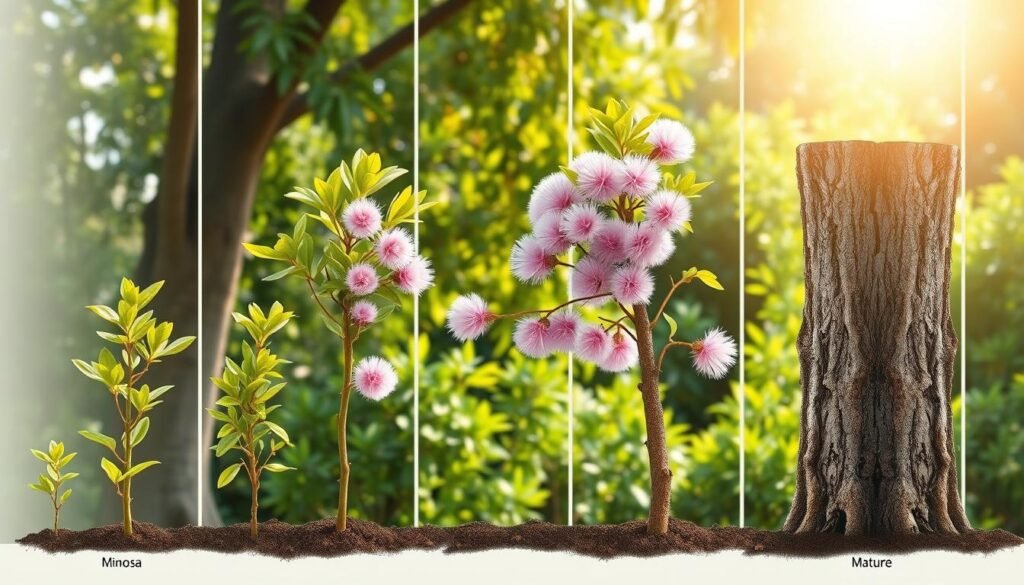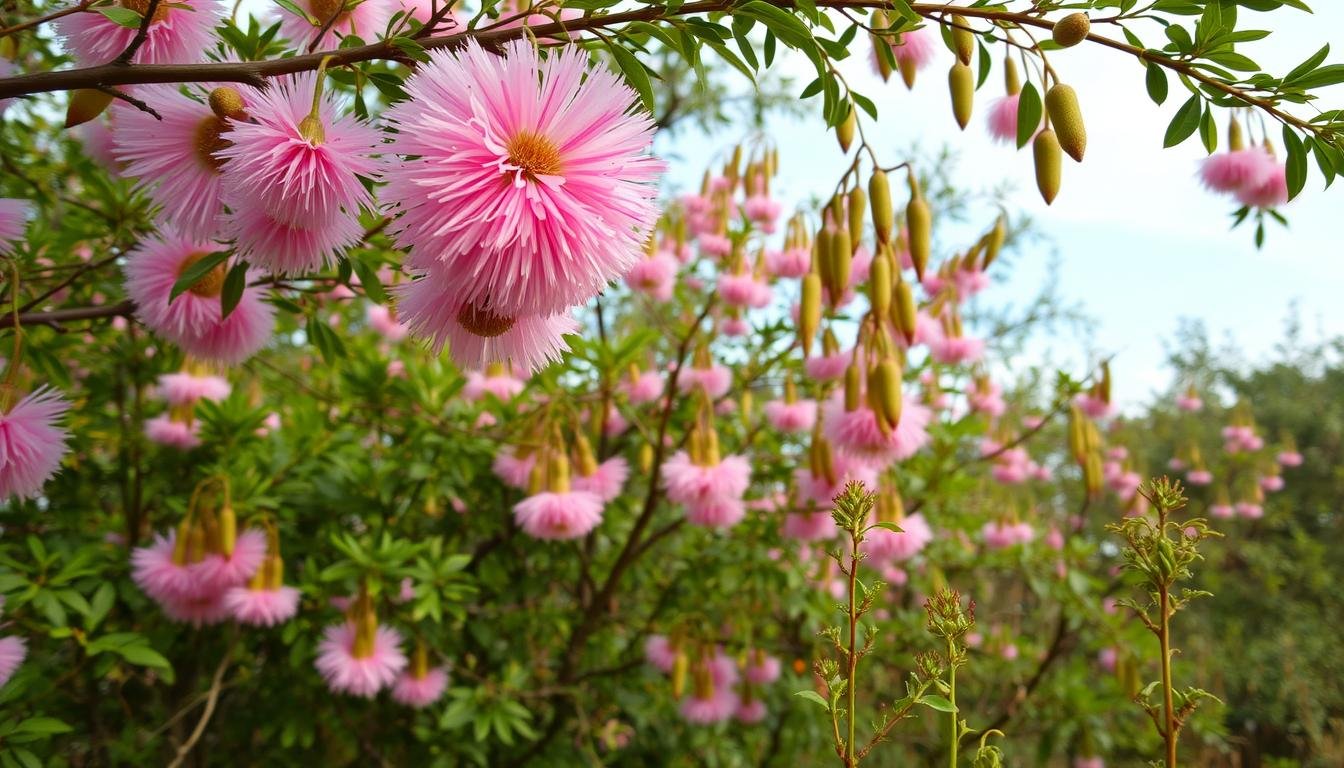Standing under the Mimosa tree’s arching branches, I admire its pink blossoms. This “silk tree” is not just beautiful; its growth is fascinating. But, Mimosa trees have a side that’s not so pretty.
Learning about how do Mimosa trees seed and grow, I see nature’s beauty and its dark side. Knowing how they reproduce helps us enjoy their beauty responsibly. Let’s explore how these trees spread and grow.
Key Takeaways
- Mimosa trees can reach 40 feet in height and spread up to 35 feet.
- They thrive in areas with at least six hours of full sun each day.
- Their adaptability enables them to flourish in temperate climates.
- When introducing mimosa trees, proper watering is essential for growth.
- Mimosa trees require around 70-80°F for optimal seed germination.
- Seedlings typically take about 2-3 weeks to emerge from the soil after planting.
- The fragrance of blooming Mimosa trees attracts various pollinators like bees and butterflies.
Table of Contents
Introduction to Mimosa Trees
The mimosa tree overview shows a fascinating species. It’s known for its unique look and fast growth. Their fluffy pink flowers in summer are especially eye-catching, making them a popular choice for gardens.
These trees can grow up to 35 feet tall. When they’re fully grown, they spread about 50 feet wide. The characteristics of mimosa trees include their soft, fern-like leaves and flat, light brown seeds that are about ½ inch long.
Mimosa trees grow fast, reaching big sizes quickly. Their big canopies offer lots of shade, making outdoor areas better. They also attract butterflies and hummingbirds, which is great for gardeners.
The benefits of mimosa trees go beyond looks. Their flowers and bark are used in herbal medicine.
But, there are challenges with mimosa trees. They produce a lot of seeds, which can grow into many new trees. This can be like having weeds. It’s important to know how to control their growth. More info is available at this link.
It’s key to think about both the beauty and the impact of mimosa trees. This helps us understand their place in gardens and nature better.
What Are Mimosa Trees?
The mimosa tree, known as Albizia julibrissin, is special for its looks and role in nature. It’s a tree that people like to grow and also a worry for the environment. It can grow up to 40 feet tall and spread about 35 feet wide.
Its leaves look like ferns and its pink flowers bloom from May to July. These flowers are not just pretty. They also help bees and butterflies, making the tree good for nature. Mimosa trees need at least six hours of sun a day to grow well.
These trees come from warm places and do well in cooler areas too. Since the 1700s, they’ve been loved in Europe and other places. They’re still a favorite among gardeners today.
Mimosa tree seedlings start to grow 2-3 weeks after planting. They do best when moved to bigger pots or gardens when they have a few true leaves. The seeds need to soak in warm water for 24 hours to grow better.
Native Regions and History of Mimosa Trees
The mimosa tree native regions are in the Middle East and Asia. It’s amazing how this tree traveled to America in the 18th century. In 1785, botanist Andre Michaux brought it to the U.S. It quickly adapted to many climates, especially in the South.
The history of mimosa trees shows they are both beautiful and invasive. Their pink flowers and fast growth are lovely. But, they can take over local ecosystems. This has led to the creation of non-seed bearing varieties.
Mimosa trees also have cultural value. In traditional Chinese medicine, they help with insomnia and depression. They add beauty to gardens but need careful planting to prevent harm.
For more gardening tips and insights into various plants, check out Beegreen Garden.
| Characteristic | Details |
|---|---|
| Height | 20 to 25 feet |
| Width | 10 to 20 feet |
| Location Introduced | America (1785) |
| Known Cultivars | Summer Chocolate, Ishii Weeping |
| Ecological Status | Invasive in some regions |
The Life Cycle of Mimosa Trees
The life cycle of Mimosa trees is full of interesting stages. It starts with seeds germinating. These seeds can grow into seedlings that reach up to 5 feet in one season.
As they grow, these seedlings turn into tall trees. They can grow up to 25 feet tall and spread 10 to 20 feet wide. They grow best in zones 6 through 10.
Between May and July, Mimosa trees bloom with pink flowers. These flowers attract birds, butterflies, and honeybees. The sweet nectar they produce is a big draw.
The flowering period is key for the tree’s life cycle. After blooming, the fruits grow. They mature between August and September.
Each fruit has 5 to 16 seeds. These seeds will grow into new Mimosa trees. The seeds also attract wildlife, helping the ecosystem.
Learning about the growth cycle of mimosa trees shows their importance. They can live for 30 years with the right care. Pruning in winter helps them stay healthy.
But, they can be invasive in places like North Carolina and Japan. Gardeners need to watch their growth. Researchers are working on non-seed bearing varieties to stop the spread.
The Mimosa tree’s life cycle is a beautiful example of nature’s power. If you like resilient plants, check out Hoya plants here.
How Do Mimosa Trees Seed
Mimosa trees have a unique way of seeding. They grow flowers, then make seed pods. These pods protect the seeds and help spread them. This shows how mimosa trees can grow in different places.
Seed Pod Formation
After the flowers fade, mimosa trees start making seed pods. These pods are brown and long, holding many seeds. When they dry, they open, letting the seeds out. This helps the tree spread to new areas.
Seed Dispersal Mechanism
Seeds from mimosa trees can spread in several ways. The wind or animals can carry them. When they find the right spot, they grow quickly, in just five to ten days. This fast growth can be a problem in some places.
| Seed Pod Characteristics | Seed Dispersal Methods | Germination Time |
|---|---|---|
| Brown and elongated | Wind, animals | 5-10 days |
| Contains multiple seeds | Natural breakage of pods | Optimal conditions enhance germination |
| Opens as it dries | Spread into surrounding areas | Water soaking recommended before planting |
Mimosa Tree Pollination

The pollination of mimosa trees is key to their life cycle. Their fragrant flowers draw bees, butterflies, and hummingbirds. These visitors help spread pollen, which is vital for seed production.
Mimosa flowers are pink and fluffy, blooming from May to June. They are about 2 inches big. These flowers attract many pollinators, which are crucial for our ecosystems.
The bond between mimosa trees and pollinators shows how plants and animals are connected. Mimosa trees help many species by offering food and shelter. Knowing this helps us protect both the trees and their pollinators.
Mimosa Tree Seed Germination Process
Learning about mimosa seed germination is key for healthy plant growth. The first step is scarification, which means nicking or scraping the seed shell. This helps water get in easier.
Then, I soak the seeds in warm water. This makes them swell and sprout, showing life before planting. After soaking, it’s important to plant them right for good root growth. Choosing bigger, more mature seeds usually leads to better growth.
Mimosa seeds need specific conditions to grow. They do best in well-drained soil and lots of sunlight, at least six hours a day. Bad soil or too little light can cause problems like root rot. I keep an eye on the soil’s moisture to avoid too much water.
When planting, I make small holes or furrows 2 to 3 feet apart. For indoor starts, a 1/4 to 1/2 inch depth in good potting mix is best. Keeping it warm helps. Cold stratification can also help seeds germinate better. Paying attention to these details is crucial for strong seedlings.
Mimosa Tree Propagation Techniques
Learning about mimosa tree propagation techniques makes gardening better. I can plant seeds or use vegetative methods. Each way has its own benefits. Let’s look at growing mimosa trees from seeds and vegetative propagation.
Growing from Seed
Starting with growing mimosa trees from seeds is key. It’s important to prepare and care for seeds well. Here are the first steps:
- Harvesting seeds: Pick mature seed pods that are brown and dry.
- Scarifying seeds: Soak them in hot water for 24 hours. Then, soak in lukewarm water for 12-24 hours.
- Stratifying: Put seeds in a damp paper towel or bag for 4 to 6 weeks. This helps them grow better.
- Planting seeds: Plant them in well-drained soil, 2 to 3 feet apart. Keep the temperature at 70-75°F (21-24°C).
- Watering: Keep the soil moist but not too wet. This helps the seedlings grow.
With the right care, seeds can take weeks to months to grow. They become beautiful new plants.
Vegetative Propagation
For a quicker way, I use vegetative propagation of mimosa through semi-hardwood cuttings. It’s a simple method:
- Select cuttings: Pick semi-hardwood cuttings that are 4 to 6 inches long. They should have at least 2-3 nodes.
- Prepare cuttings: Trim the bottom leaves. This helps them root better. You can also dip the cut end in rooting hormone.
- Plant cuttings: Put the cuttings in well-drained soil. Make sure at least one node is buried.
- Water and maintain humidity: Keep the soil moist. Use a plastic bag or dome to keep humidity high.
- Monitor growth: New growth should appear in 4-6 weeks. This means the cutting has rooted well.
Using these mimosa tree propagation techniques, I can grow new trees. Both seed and cutting methods have their benefits. They help make my garden beautiful with mimosa trees.
Mimosa Tree Growth Stages

Mimosa trees grow from seedlings to mature trees. Knowing these stages is key for growing these trees. I’ll talk about young seedlings and their care. Then, I’ll discuss mature trees, their benefits, and challenges.
Young Seedlings
Young mimosa trees need the right care to grow. They start small, growing 2 to 6 inches tall. They need lots of sunlight and well-drained soil.
It takes 1 to 3 years for them to grow. With good care, they can grow 1 to 2 feet each month. Mimosa trees do well in zones 6 through 10 and like different soils.
They need water, especially when it’s dry. Seeds germinate best between 70°F to 85°F. They sprout in 7 to 14 days with the right conditions.
Mature Trees
Mature mimosa trees grow tall and wide after 3 to 5 years. They can reach 20 to 25 feet tall and 10 to 20 feet wide. Their pink flowers attract pollinators from May to August.
These trees are good at surviving without much water. But, they can get diseases like Mimosa Wilt. This can make leaves turn yellow and wilt.
Mature trees are also good for animals. They provide seeds for birds and other wildlife. They grow fast, up to 3 to 5 feet a year. But, they can be invasive in some areas, affecting local plants.
| Growth Stage | Height/Size | Care Needs | Characteristics |
|---|---|---|---|
| Young Seedlings | 2 – 6 inches | Full sun, well-drained soil, adequate watering | Rapid growth rate (1-2 feet/month) |
| Mature Trees | 20 – 25 feet tall, 10 – 20 feet wide | Drought tolerance, disease monitoring | Flowers from May – August, seeds attract wildlife |
Environmental Considerations for Planting Mimosa Trees
Planting mimosa trees can affect the environment. They look nice but can change local ecosystems a lot. Their seeds spread fast, making them invasive in places like Japan. With careful planning, we can lessen these problems.
Things to think about when planting include:
- Invasive Potential: Mimosa trees can push out native plants, harming habitats. It’s smart to check the area first before planting.
- Ecological Impact: They grow quickly, covering other plants and reducing diversity. This is key for a varied garden.
- Soil and Sunlight Requirements: They need good soil and lots of sun. They grow best with at least six hours of sun a day.
Choosing the right mimosa tree is also important. Some, like ‘Summer Chocolate,’ are less invasive and look special. Planting them responsibly keeps their beauty while protecting the environment. It’s important to think about these points before planting.
I suggest that garden lovers consider these environmental effects when planning their gardens. Making smart choices lets us enjoy mimosa trees, improve our gardens, and help our ecosystems.
Conclusion
In summary of mimosa trees, I’ve talked about their amazing qualities. Albizia julibrissin is a standout in landscapes with its bright pink flowers. These flowers attract bees and butterflies, adding beauty and helping nature.
These trees grow well in many soils and can handle tough conditions. But, they can also spread too much in some places. It’s important to think about how they might affect the environment before planting.
This article covered how to grow Mimosa trees, from starting seeds to the best growing spots. It’s all about gardening right and thinking about the impact on nature. We need to plant these trees wisely to avoid harming local plants and animals.
While Mimosa trees can make gardens lovely and cool, we should think carefully about their effects. If you want to improve your garden or help local nature, knowing the pros and cons of Mimosa trees is crucial. This way, we can make choices that are good for both our gardens and the environment.




